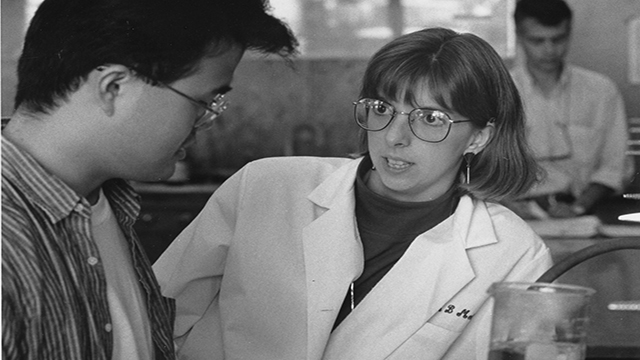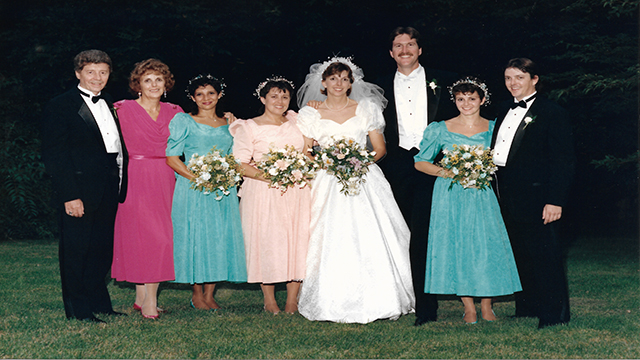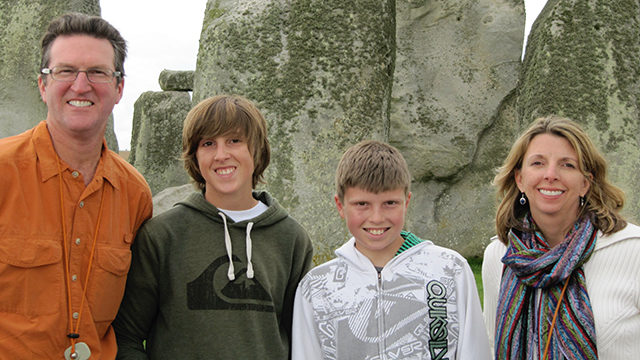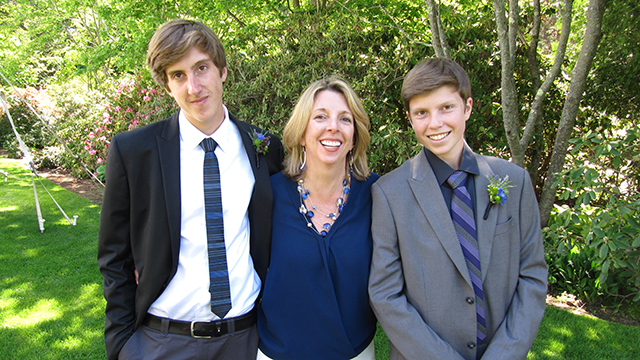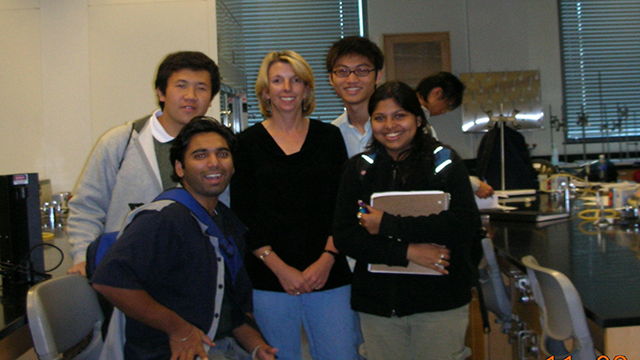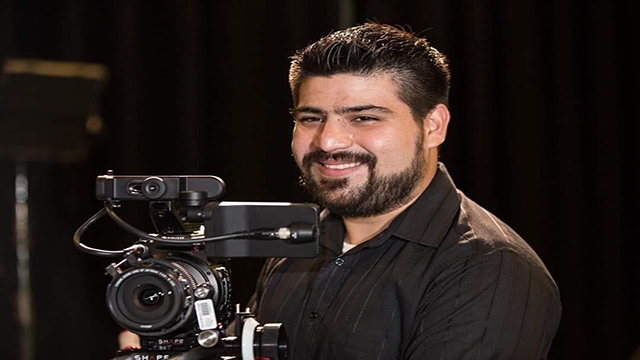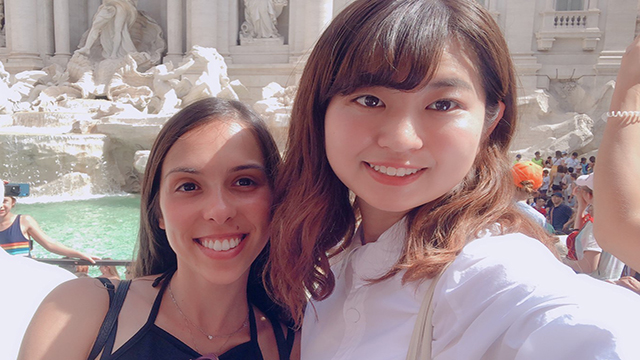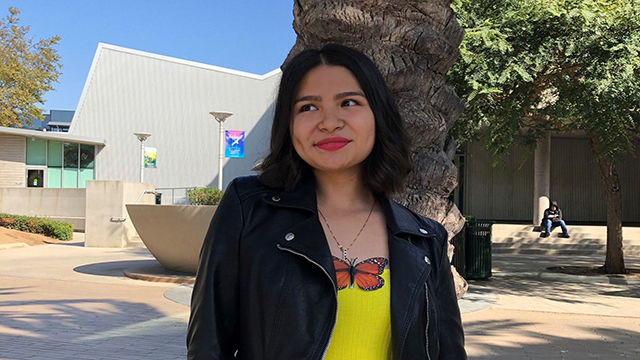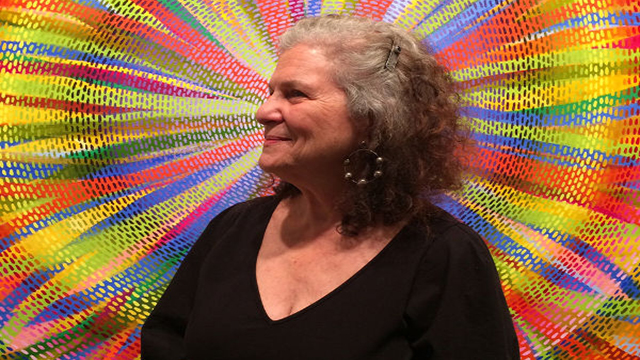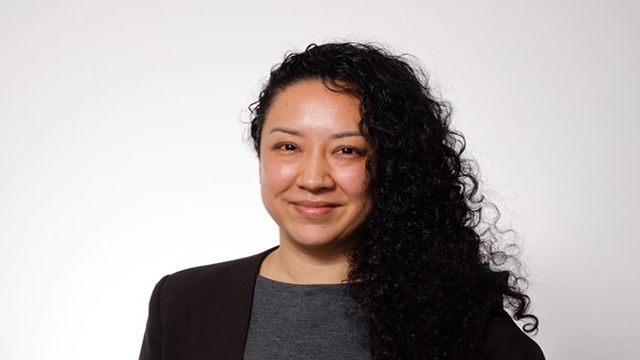Leaving Home: Jenny Merlic

Santa Monica College is the kind of place many think of as “home.” It isn’t unusual to find colleagues who have spent a huge chunk of their lives—decades, entire careers—here. Children are born and grow up, places lived in and left behind, new technologies are found and grow obsolete, time passes. Vice President of Academic Affairs Dr. Jennifer “Jenny” Merlic is one such colleague. Jenny, who is retiring this June, has spent over three decades at the college—first as a chemistry professor, and then in several roles including as Chair of the Physical Science Department, Director of Academic Computing, Dean of Instructional Services, and more. In her own words, retiring from SMC will be, in a sense, like leaving home.
SMC in Focus brings you this exclusive interview with our longtime family member; the conversation has been slightly edited for clarity and brevity. Jenny talks about moving across the country for love, having her honeymoon cancelled due to a new compressed SMC calendar, what it was like to be a female student at male-dominated Princeton University in the 1980s, the highlights of her life at SMC, and what she will be doing when she retires. Read on!
SMC in Focus: You first came to SMC as a chemistry professor. Tell us a little about the influences that shaped your interest in that field.
Jenny: Oh, that's a pretty easy one. Both of my parents were educators. So, the dinner table conversations were always about school. My dad had been a sixth-grade science teacher and he also ran a summer camp for kids—later he became a guidance counselor at a junior high school. My mom has always been passionate about [higher] education—it had been denied to her as a young person. Her family were immigrants. They didn't believe that girls should go to college. So if a high school counselor put her in an algebra class, they would call and complain and say, no, she needs shorthand and typing. And so, after she married my dad, she started some college prep classes, and began attending college after her fourth child—my youngest sibling—went to preschool. My mom and I got our doctorate degrees the same year!
SMC in Focus: No way.
Jenny: Education runs through my blood and my family's interests. Science is part of it, too . . . I would attribute that to my brother David, who's four years older than I am. Oh my gosh, everywhere we went, he’d tell me with incredible passion about the trigonometry/calculus/something he was learning in math or science. And he was so passionate. He's a great teacher, and a physicist now. He’d make me think: “Oh my God, I can’t wait until I can take trigonometry! Why am I stuck in pre-algebra? (or whatever it was)”. He was that stereotypical science nerd kid who always had some project going on. So, you'd walk into his bedroom and you'd never know if you were going to trip some beam of light that would set off an alarm or what you would find. He got me really, rally jazzed about science, and as a kid, I went into new math and science classes with this incredible anticipation. I think I’m a pretty smart person, but my brother is brilliant.
And the last thing I would add is that I went to Smith College as an undergraduate. It's an all-women’s college. [That was a crucial point] especially then going on to Princeton as a graduate student where I was the only woman in my program. I don’t know if I would have been a scientist if I’d started out at a co-ed institution—I chose to go into a heavily male-dominated field from within the cocoon of an all-women’s institution.
SMC in Focus: What was that like—being the only woman in your class?
Jenny: It was a weird experience in so many ways. Princeton at that time—fall 1983 was when I started there—was still predominantly white male. There was a lot of culture shock involved in being there. For example, there's an area called the Graduate College. It looks like something out of Hogwarts—there is a dining hall with big, long tables and, on one end, there's a raised dais with a big table there, too. On Thursdays, we would have “high table dinner” where there would be invited guests—key faculty and deans who would wear their academic garb for dinner and sit at the high table . . . that kind of old-fashioned tradition. There was a whole group of engineering first year grad students—all guys who just were so turned off by that pomp and circumstance—who started having “low table” on Thursday nights. So, when the high table was going on, they would leave their regular table and sit on the floor and eat with their hands.
Princeton had just started admitting women in the sixties, and they hadn’t really retrofitted those buildings originally built when it was an all-male institution, these old stone castle-like things. So, that first year, I lived in a dormitory with co-ed hallways and co-ed bathrooms with shower stalls and a common dressing area with only curtains for doors! Women were such an afterthought.
And then in my own research group, I was the only woman. And there were no women on the faculty. My advisor was a very old-fashioned kind of man too. I was assigned the refreshments. I was assigned giving tours to visitors because I was personable and friendly, and when we went to conferences, I always had to go separately . . . all the guys, the six male grad students and the professor would travel together, but he thought it was inappropriate for a single woman to travel with them. Weird things like that. They’d go white water rafting and such, but I’d have to go to a separate conference by myself. You felt like you weren’t really part of the group.
SMC in Focus: You earned your graduate degree at Princeton and then also a PhD there in Physical Chemistry, right?
Jenny: Yeah. I worked in a laser lab where I was finding ways to have a computer control details of the laser light, such that it would have a certain impact on the behavior of the molecules we were studying. It feels like that was in another lifetime . . .
SMC in Focus: So you grew up on the East Coast, went to school there. What brought you to Santa Monica College?
Jenny: When I went to Princeton to get my graduate degree, I really wanted to teach; I’d had fabulous faculty at Smith and it was my dream to go back to an institution like that, teach there. Not necessarily an all women’s college, but a liberal arts institution. At Princeton, I never really lost that. I did not want to go into a research institution. My research experience at Princeton wasn't one that I loved. I found the whole thing a little bit—I don't know—just disappointing. I went there with a lot of naiveté, thinking I was going to be with people who were just passionately pursuing new knowledge, but instead there were all kinds of petty, egotistical squabbles and infighting—each person always trying to prove he was the smartest one. It was very disillusioning.
I was a teaching assistant for most of my graduate years and never stopped loving working with students. So, that was easy. I knew I was going to go into teaching. I met my husband, Craig. He was a post-doc at Princeton; he’d finished his PhD at University of Wisconsin-Madison and got a professorship at UCLA while we were dating. It was one of those situations where he's moving across the country, we’d only been dating a few months, so you either end a relationship or accelerate it, really. He said, ‘Would you be interested in moving out there with me when you’re finished?’ So there he was at UCLA in Westwood. And I was still at Princeton doing the last of my experiments. We were very much in love. He would send me a ticket to fly out once a month, and we'd have a weekend together. And then I’d go back and do more experiments. But like the [very] day that I finished my last experiment, I moved to Westwood and moved in with him. And then I wrote my dissertation from Westwood. I’d grown up in a town of 3,000 people in Western Massachusetts. Smith College was only 45 minutes from my childhood home. And that's in a bigger city, but it's still very small. And Princeton is a tiny little town. And then I moved to LA . . . I’d never lived in a city, ever. And I think the writing of my dissertation was probably slowed down because I was so distracted. Like, I can just walk four doors down and get a cappuccino?!
And while I was writing my dissertation, I was applying for postdoctoral positions and got one at USC. I was not quite done with my dissertation, but they let me start my post-doc. So, I was doing research in a lab at USC—the first time I had a female advisor and she was great. She still is great. I'm still in touch with her—Hannah Reisler—from time to time. And while I was finishing up my dissertation, my husband noticed a Chronicle of Higher Education ad for a teaching position at Santa Monica College. Meanwhile, we had just bought a house in Mar Vista. I was like, wait a minute, where is this Santa Monica College? It turned out it was a 10-minute drive from our house. It seemed like destiny. I wasn't done with my post-doc, but I applied for the job anyway. And when I got the job, I let my advisor know I would be leaving my post-doc early. We didn't have a whole lot of money, so I didn't fly back to the East Coast much. So, in August of ‘91, I had a crazy whirlwind week. I flew back to Princeton on a Tuesday. I defended my dissertation on Wednesday, and then picked Craig up at the airport and drove up to Northampton, Massachusetts for our wedding. That was a Saturday and on Monday morning, classes started at SMC!
SMC in Focus: Wow.
Jenny: But it was not supposed to be that way—when I was hired, the semester was scheduled to start two weeks later. We had a two-week honeymoon planned. I still remember Rocky Young [Darroch “Rocky” Young, then SMC Vice President of Academic Affairs] calling me in May and saying, “We've just voted to switch to a compressed calendar. And we'll be starting classes two weeks early. Is that a problem for you?” It's always embedded in my mind—the year we switched to the compressed calendar, 1991—because we had to cancel our honeymoon.
[Editor’s Note: Jenny and Craig have raised two sons—Kyle, 25, an avid rock climber and a forester by day who’s living “out in the woods and building himself a tiny house”; and Aidan, 22, who is a student at Santa Monica College and will be getting an Associate Degree for Transfer in Psychology, this June. Aidan flips cars “to get his spending money.”].
SMC in Focus: You started as a chemistry faculty member. How many years did you teach before becoming an administrator in what was called Instructional Computing back then, right?
Jenny: It wasn't that long. . . it was kind of a gradual transition because my husband had a chemistry grad student at UCLA, who was very into computing and told us about this new thing called the worldwide web and how it was going to change education and life as we know it. He wrote the programming for VOH, Virtual Office Hours—it was a very early precursor to systems like Canvas, Blackboard, and Moodle, a place where faculty could post documents for students to view online. It had a simple threaded discussion kind of functionality. So, students could post questions and a faculty member could respond and then, of course, have virtual office hours. This grad student wrote coding that would take the class schedule and automatically generate one of these webpages for every class. And then we hired students to help faculty because you had to know HTML to post your documents, et cetera. Craig and I wrote a grant together to extend that to the physical science department at SMC.
I was still faculty. But we got this little grant and Apple donated a server. So, I had a web server on my desk and I ran VOH for all of chemistry and physics. And then the Life Science [department] was like, ‘This is really cool. Will you do it for us?’ So, I did.
Rocky got wind of this and asked me to present it to the Board, to Curriculum Committee, to department chairs. And he asked me if I would work with the college's IT department to bring it campus wide. It was supposed to be just a summer assignment, but the state put forth a bunch of categorical funds, through a program called TTIP—Technology, Training and Infrastructure Program—to help colleges figure out how to use these new internet-based technologies for teaching. Rocky asked me if I would be interested in having reassigned time to do research and be a liaison between IT and faculty and help in bringing the technologies into education effectively.
I did that for two years on “reassigned time”. Then the person who was running the academic computing office resigned, and I became an official director [of academic computing] at that time.
SMC in Focus: Jenny, because you've served SMC in so many different roles— Director of Academic Computing, Director of Tech Training & Research, Chair of the SMC Physical Science department, and Chair of the Academic Senate Department Chairs Committee, Dean of Instructional Services, and then, of course, VP of Academic Affairs—this question might be a little difficult: if you had to boil down your decades-long career into three top highlights, absolute high points, what would those three things be?
Jenny: I would say getting involved in the Academic Senate leadership and being Chair of Chairs—that whole experience was one of the best, because I just learned so much. When you have a team that gels and you're friends with the people you're working with—it wasn’t like we socialized; but we clicked well, had common goals, and were able to make good progress. This included other faculty, Senate leaders like Eric Oifer, Janet Harclerode, Christine Schultz and Eve Adler—but also Georgia Lorenz and Randy Lawson and Jeff Shimizu, that team. Those were good years where we made a lot of progress and I learned a lot about how community colleges function at the state level, and about the inner workings of SMC, if you will.
And I’ve been thinking about this silly joke about PhDs that says you learn more and more about less and less until you know everything about nothing. It does kind of convey how very, very specialized one can be in their dissertation, especially in a very mature science, like chemistry, where to get to the forefront of knowledge and actually push that knowledge, you really have to specialize. So coming to SMC, just even teaching general chemistry was broadening my scope so much, and then working as chair and being exposed to all of the other departments. So, I feel like until I got my PhD, I was going narrower and narrower, and then coming to SMC, [my world] just broadened. That was a big highlight—not being a specialist, but becoming much more of a generalist. So, that's one [highlight]. . . there are lots of them. I've absolutely loved my career.
#2. Working with the team to write the proposal for SMC’s Bachelor of Science in Interaction Design degree . . . that was pretty awesome. That was the first time I’d worked really closely with the career education programs, the Office of Workforce & Economic Development, and the SMC President's Office, as well as statewide partners. And then once we got the proposal approved, we were part of this statewide group and flying up to Sacramento all the time, going to Board of Governors’ meetings—that was also a tremendous education. And again, working with a team that was so talented and knowledgeable and focused on the same goal. I was the author of the proposal supposedly, but they [the team] were pouring in content for me, like crazy.
SMC in Focus: So that’s two highlights . . .
Jenny: Let's see . . . I had wonderful experiences in IT as well. The influence of [former Dean of IT] Jocelyn Chong and [then Executive Vice President] Randy Lawson at that time, I worked so closely with both of them, day in and day out, on IT projects. Two incredible leaders, both of them, and mentors; it was a hard time, too, because IT is a challenging field, especially at the community college level where the funding is in my opinion, dramatically insufficient for the tasks IT is asked to perform. And so, trying to work with them on how to solve that issue was challenging. Jocelyn had a deep knowledge of the college’s infrastructure, saw the big picture, and was very deliberate in her decision-making.
SMC in Focus: So we have three highlights of your time at Santa Monica College . . .
Jenny: I just thought of something else . . . the ‘94 earthquakes, and the response to that. We lost our Science Building, so we were out there, measuring and spray painting a layout on the tennis courts to put up the bungalows that became known as Science Village, all during the winter intersession in order to have classes happen that spring. The president's office was on the third-floor of Drescher Hall; he [Dr. Richard Moore] hadn't moved in yet. We made it into a classroom and did labs up there with just water—that was our only chemical. It was a crazy time, but it was another one of those moments where the college just pulled together unbelievably and managed to pivot. So, we had a full spring semester . . . not a single class canceled—except for tennis…
SMC in Focus: You're retiring the end of June, Jenny. What are your plans, Jenny? What do you hope to do next?
Jenny: I've been reading some books on life transitions; the advice I've received there and that I've taken to heart is you have to allow yourself some time before making plans. If you've been a busy person, it is very tempting to immediately fill the time with something else. So, I'm planning to do no work, all summer long. My husband and I—together with my sister and her wife—bought a house on a lake in a remote corner of Maine. I'm going to spend July and August there doing things like canoeing and hiking and allowing thoughts to bubble up as they do. And then sometime in the fall, I'll start thinking about what I want to do—I know I want some kind of work in my future. I just don't know if it's going to be a volunteer work. There's a lot that I would like to get involved with around climate change.
SMC in Focus: What’s the name of one of the books that's helped you?
Jenny: There's a book that I’d purchased and read for work about managing change at institutions. An executive coach I’ve been working with mentioned a book about life transitions, and turns out it was by the same author. He applies the same philosophy to both institutional transition and personal transition. His name is William Bridges, and the book I'm reading for my personal transition into retirement is called Transitions: Making Sense of Life's Changes. The one that I read earlier was called Managing Transitions: Making the Most of Change. I read that one to try to help with the college’s [guided pathways] redesign efforts.
SMC in Focus: So, Jenny, what will you miss most about SMC?
Jenny: Well, I've had a lot of time to think about that. SMC is like a family, a complicated family that can sometimes be a little dysfunctional, but it is a family. For me, I realize that my favorite part of my job is still teaching. And people will often say, don't you miss teaching? And yeah, I miss formal teaching sometimes, but I don't think I ever stopped teaching because it's part of my job. What I like the most is helping a new faculty member, new department chairs, new administrators to understand how things work at SMC and just to become comfortable in their new roles. And I'll miss that a lot.
SMC in Focus: As you leave SMC, is there this sense that you’re leaving home?
Jenny: Oh, there’s quite a bit of that right now.
* * *




